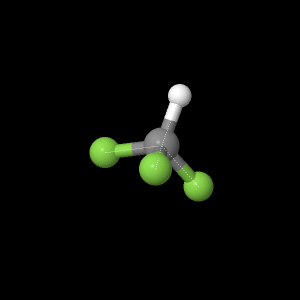Once the molecule file is fully loaded, the image at right
will become live. At that time the "activate 3-D" icon will disappear.
CHF3
Levels of Theory UsedTrifluoromethane
We used five different methods for calculating bond length. AM1 and PM3 were the simplest calculations. 6-21G, 6-31G , and Double Zeta Valence (DZV) used increasingly larger basis sets and were ab initio calculations making them computationally more difficult but theoretically more accurate.
PM3 was the second highest level of experimental geometry used to calculate bond length.
AM1 was the simplest level of theory used.
6-21G was the first ab initio calculation ran.
6-31G was another ab initio calculation with a larger basis set.
DZV was the most computationally intense level of theory used to calculate bond length.
All of the ab initio calculations gave very similar values. However, based on the literature values the DZV level of theory gave values that were slightly closer to the literature values than the other levels of theory.
Table 3: Literature Values of Bond Lengths in CHF33
| Bond |
Length (Angstroms) |
| C-H |
1.098 |
| C-F |
1.332 |
The electrostatic potential represents the potential surface around the molecule. The red regions are low electrostatic potential while the blue regions are the highest electrostatic potential. The animation shown was calculate using the DZV level of theory.
The partial atomic charge of each atom in a molecule is due to differences in electronegativity of the atom. The animation shown was calculated using the DZV level of theory.
The highest occupied molecular orbital was 17. The animation shown uses the DZV level of theory.
The lowest unoccupied molecular orbital was 18. The animation shown uses the DZV level of theory.
| Theory |
Best Dipole Moment (Db) |
Percent Error (%) |
| 6-21G |
2.106989 |
27.7 |
| 6-31G |
2.371931 |
72.2 |
| DZV |
2.334978 |
68.5 |
Literature value: 1.65 Debye3
CHF3 was an interesting molecule because the highest level of theory produced the value farthest from the experimental literature value. As the level of theory increased the error increased. 6-21G gave the value that was closest to the literature value.
Table 5: IR values obtained from literature with buttons for animations shown below3
| Type of Bond |
Frequency (cm^-1) |
| C-H Stretch |
3000 |
| C-F Stretch |
1200 |
| H-C-F Bend |
700 |
| F-C-F Bend |
500 |
Figure 1. Experimental IR Spectrum3

The dipole moment was calculated at different levels of theory and further refined using diffuse calculations
Page skeleton
and JavaScript generated by export to web function using Jmol 14.2.12_2015.01.22
2015-01-22 21:48 on Mar 9, 2015.
This will be the viewer 

If your
browser/OS combination is Java capable, you will get snappier
performance if you use Java